Why you can trust Tom's Hardware
Radeon RX 6600 1080p Gaming Performance
Like its big XT brother, the Radeon RX 6600 is primarily intended for 1080p gaming. Older games and some lighter esports fare can run at higher resolutions and still break 60 fps, but more demanding games already struggle at maxed out 1080p settings. Which is why we're also including our suite of 1080p medium results for this review.

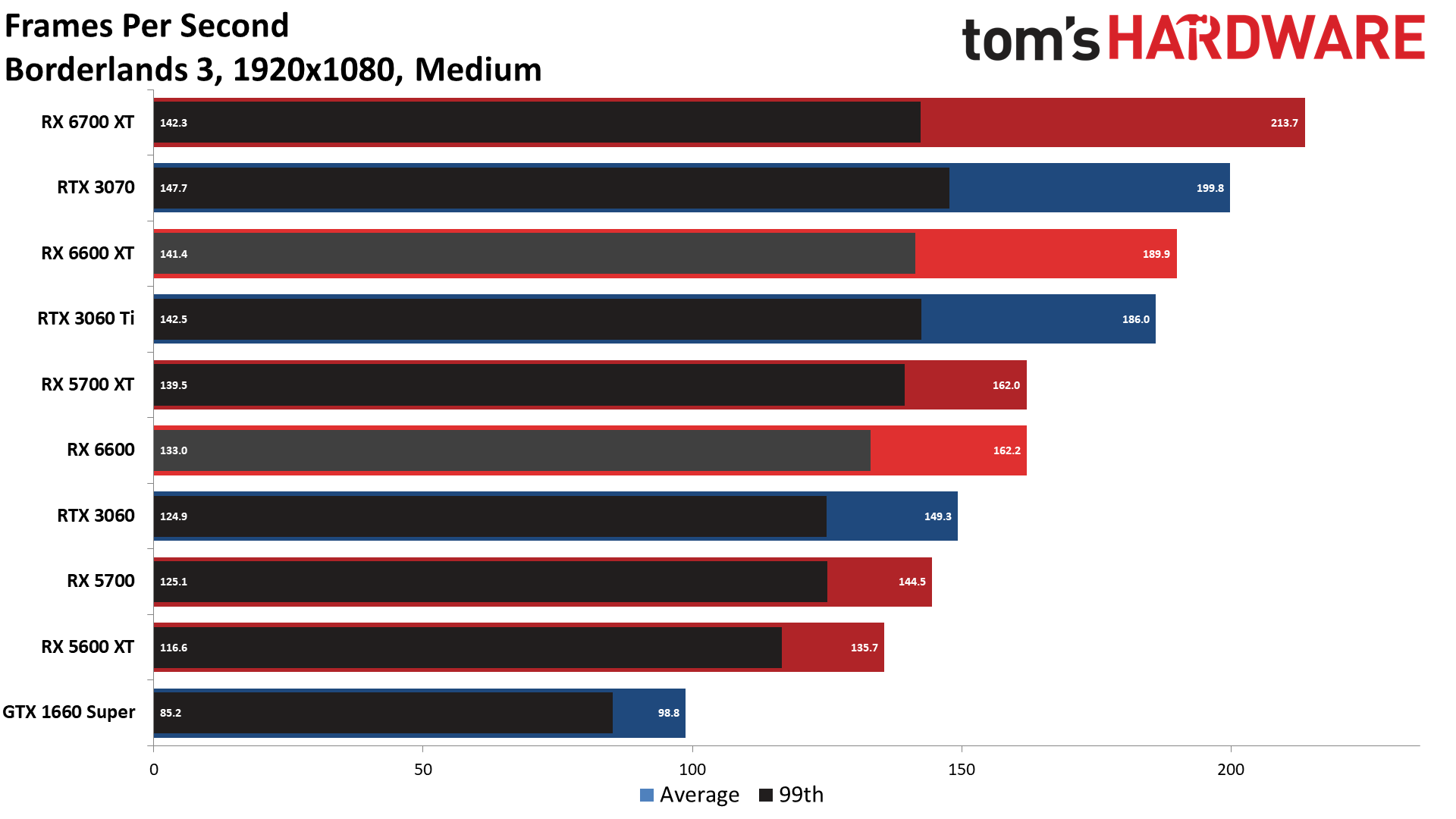
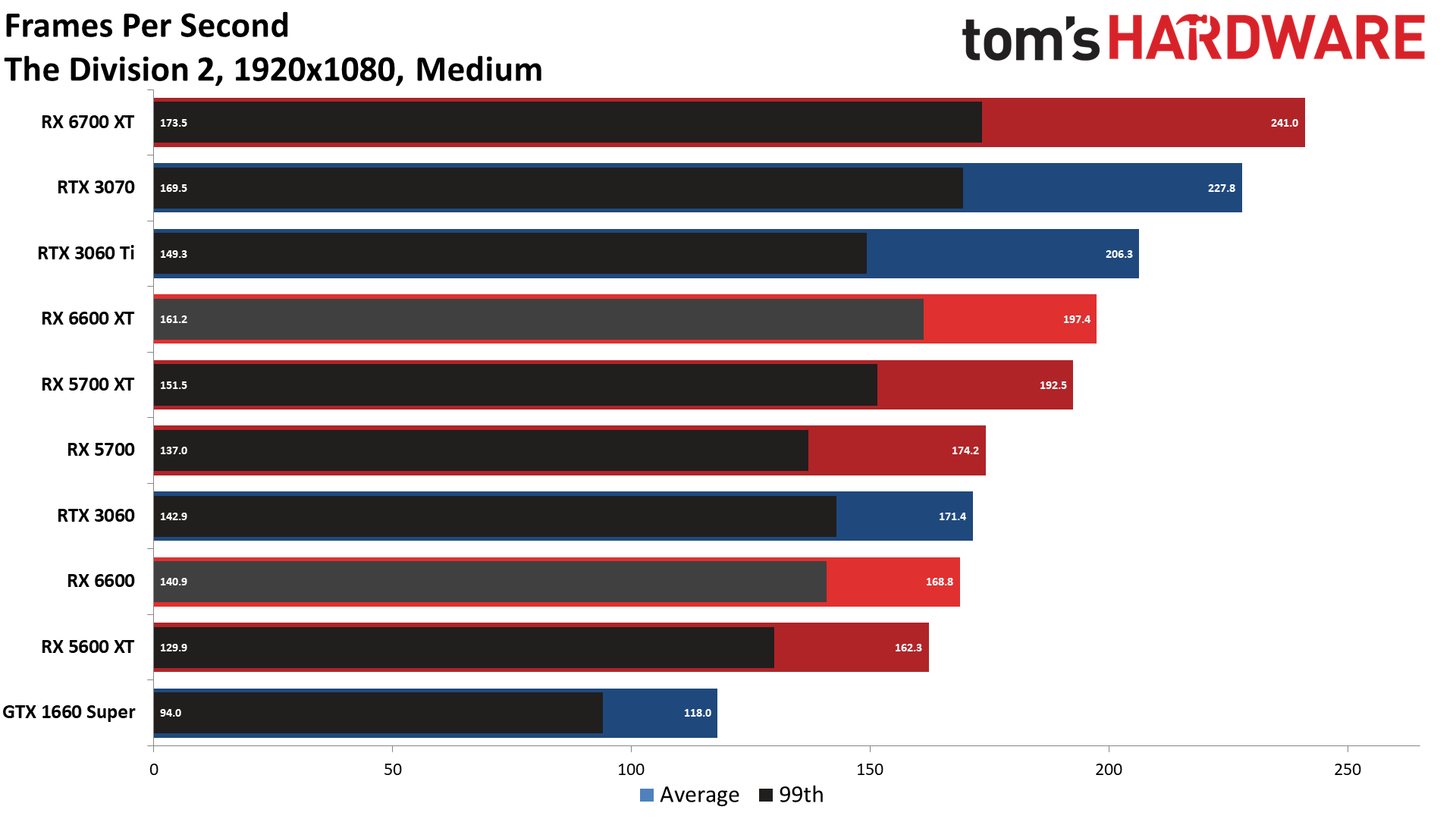



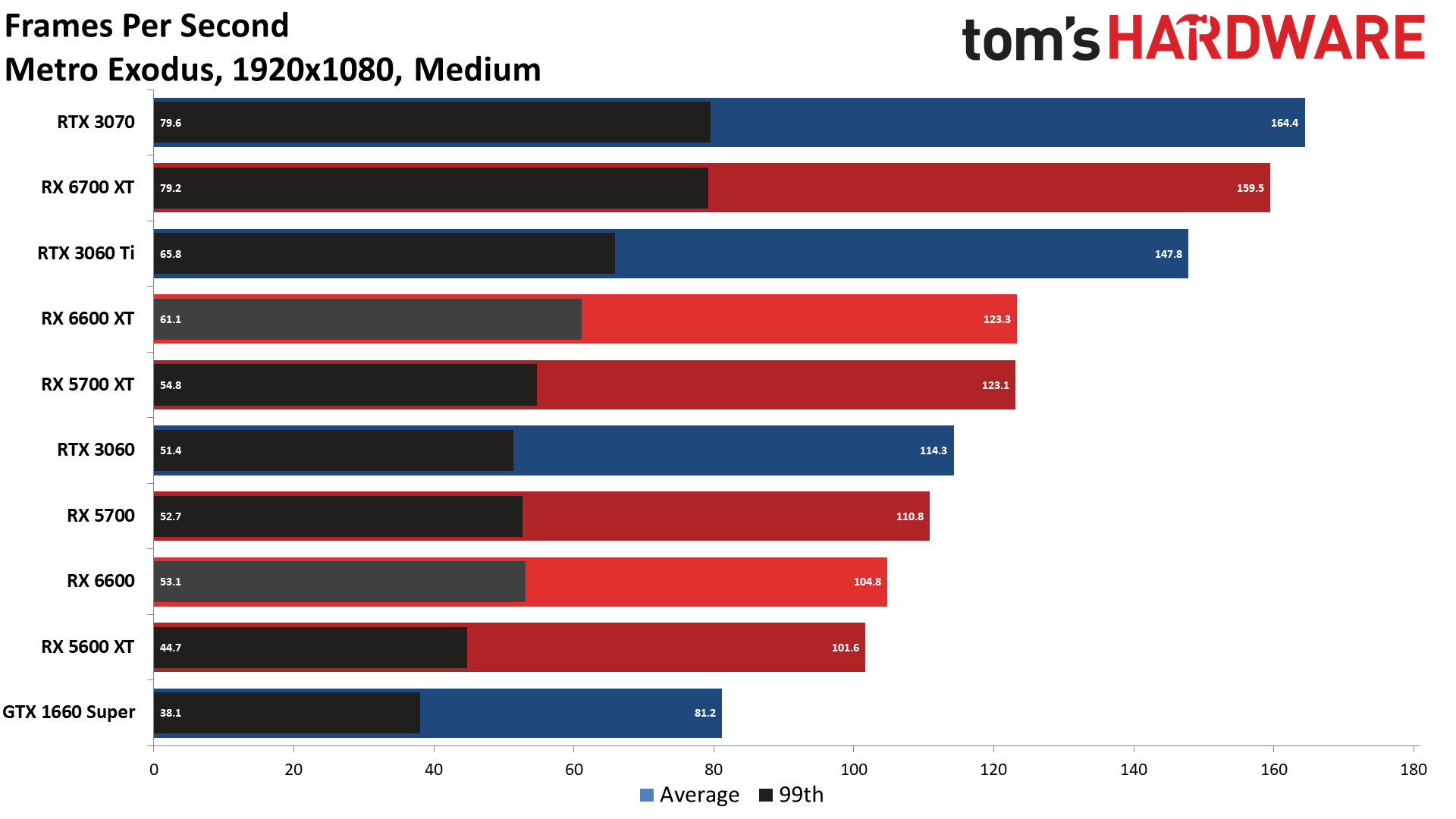

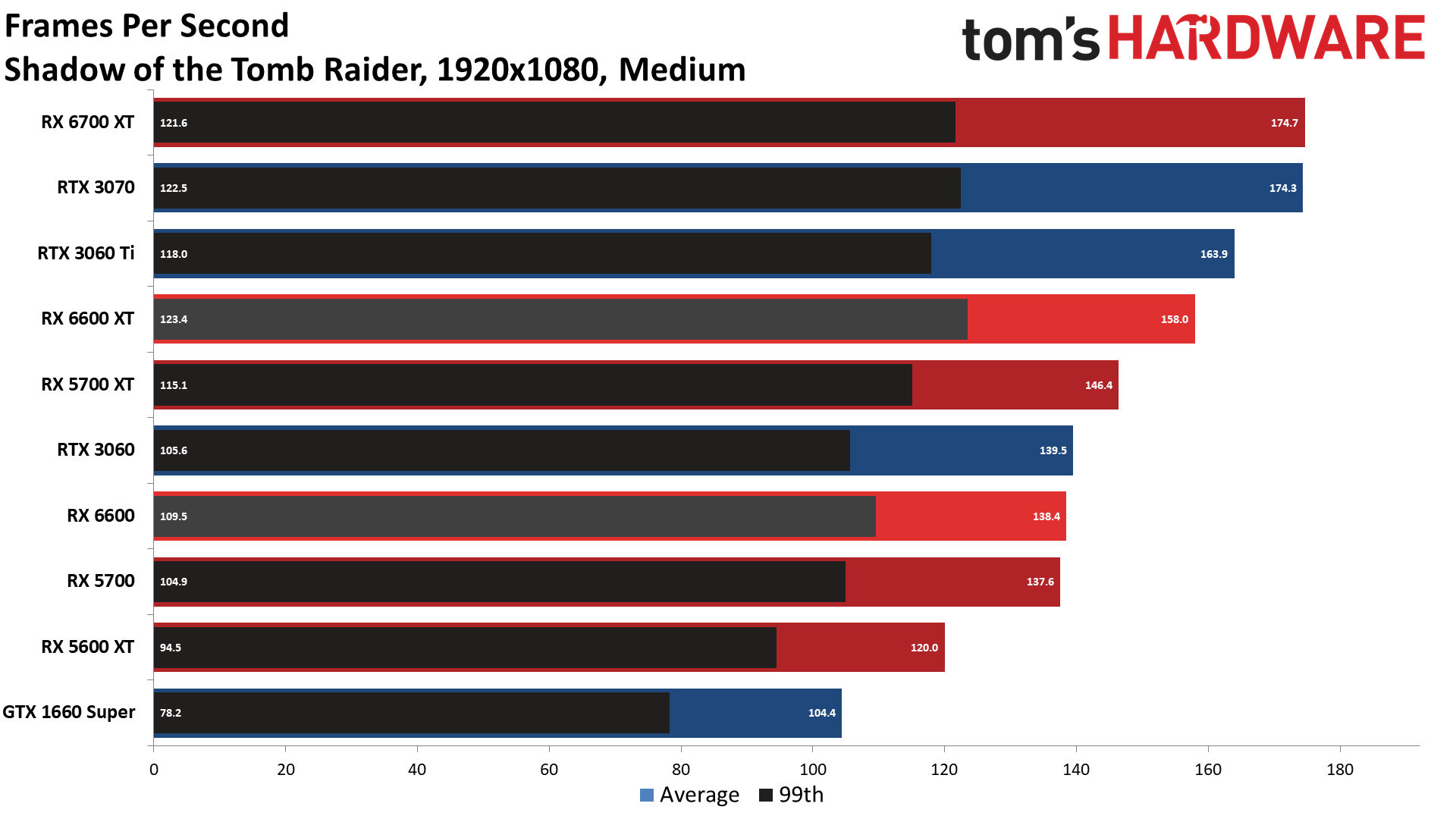
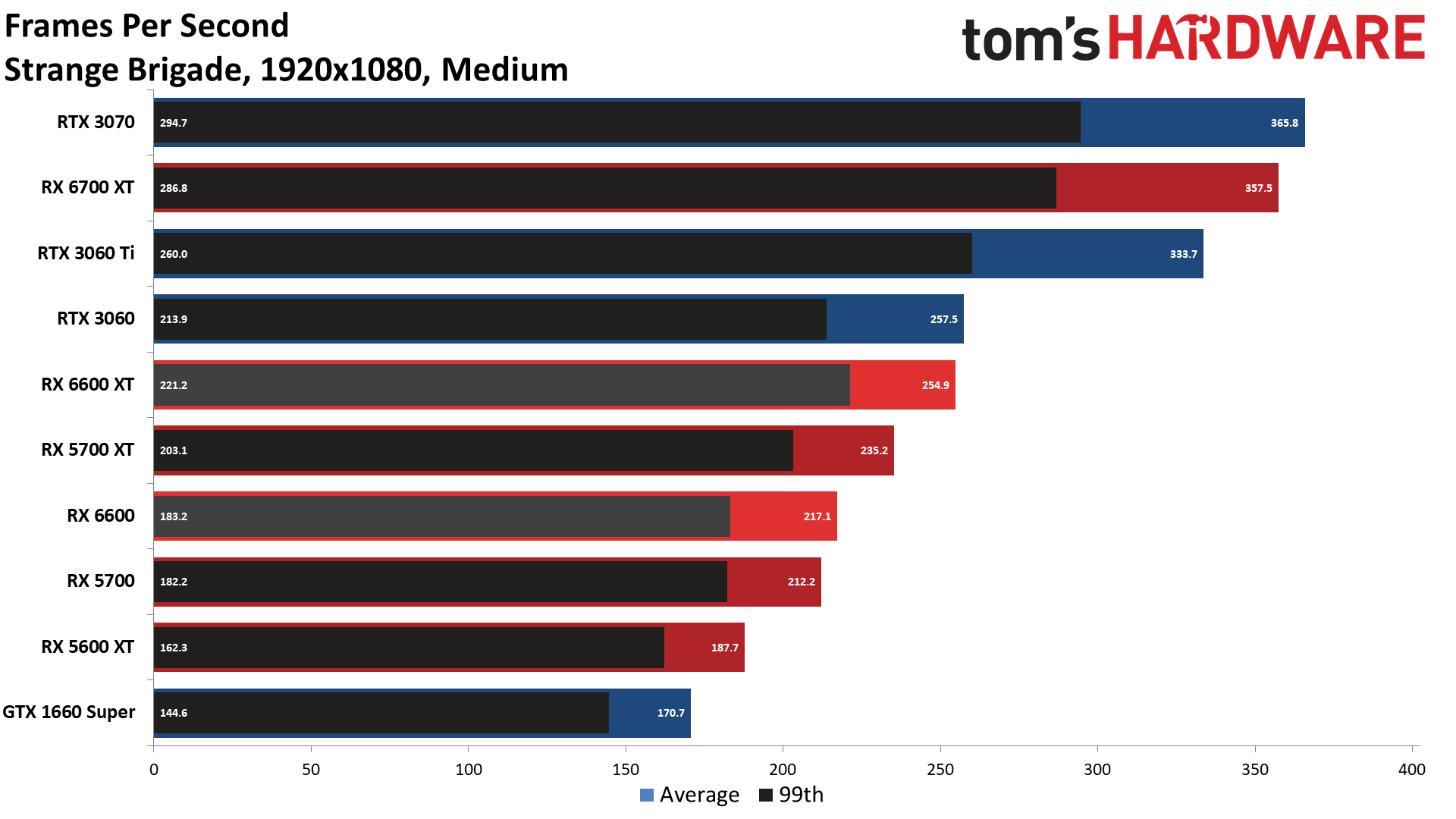
The problem with mainstream GPUs is that they generally don't offer anything new in terms of performance and features. Instead, you're supposed to get better performance and more features than the previous generation hardware, but the cards will be substantially slower than more expensive offerings. As a trimmed down Navi 23 variant, we expected performance to be 10-20% slower than the RX 6600 XT, and overall the RX 6600 falls right in that range: It was 11% slower than XT model at 1080p medium across our nine game test suite.
Perhaps more importantly, we need to look at how the RX 6600 stacks up against the RTX 3060. These cards nominally start at the same $329 price point, though in practice Nvidia's card tends to hover closer to $700 on places like eBay, or if you get lucky in the Newegg Shuffle you might be able to snag one for under $500 (with a potentially questionable bundled item). The RX 6600 XT meanwhile sells for around $600, and outside of games that use ray tracing and DLSS, it tends to be the faster card. We expect the RX 6600 will sell for at least $50 less than the 6600 XT, which means we could see prices of around $450–$550 in the current market.
In terms of performance, the RX 6600 was 4% slower than the RTX 3060. 1080p also represents something of a best-case scenario for the RX 6600, and we expect the gap to widen as we increase the quality and resolution since the Infinity Cache benefits go down at higher resolutions. 1080p medium probably sits well below where most people buying the card will play, so let's also look at how the cards fare at 1080p ultra — and generally speaking, 1080p high will land halfway between the two results.
Another point of comparison that's not shown in these charts is the RX Vega 64. The RX 6600 performed about 6% faster at 1080p and uses about half as much power, so efficiency has improved dramatically, prices are lower, and performance is roughly the same.

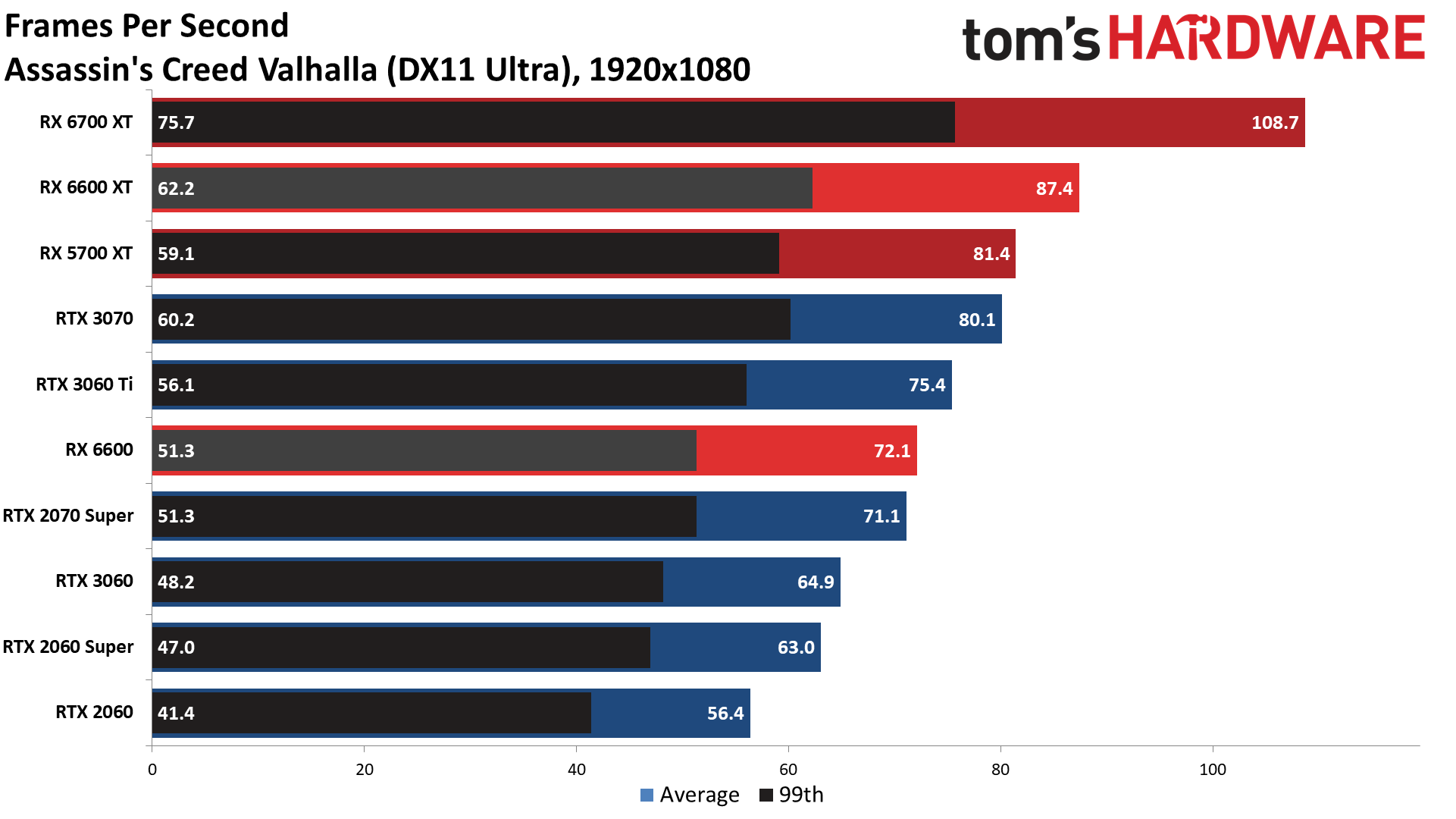



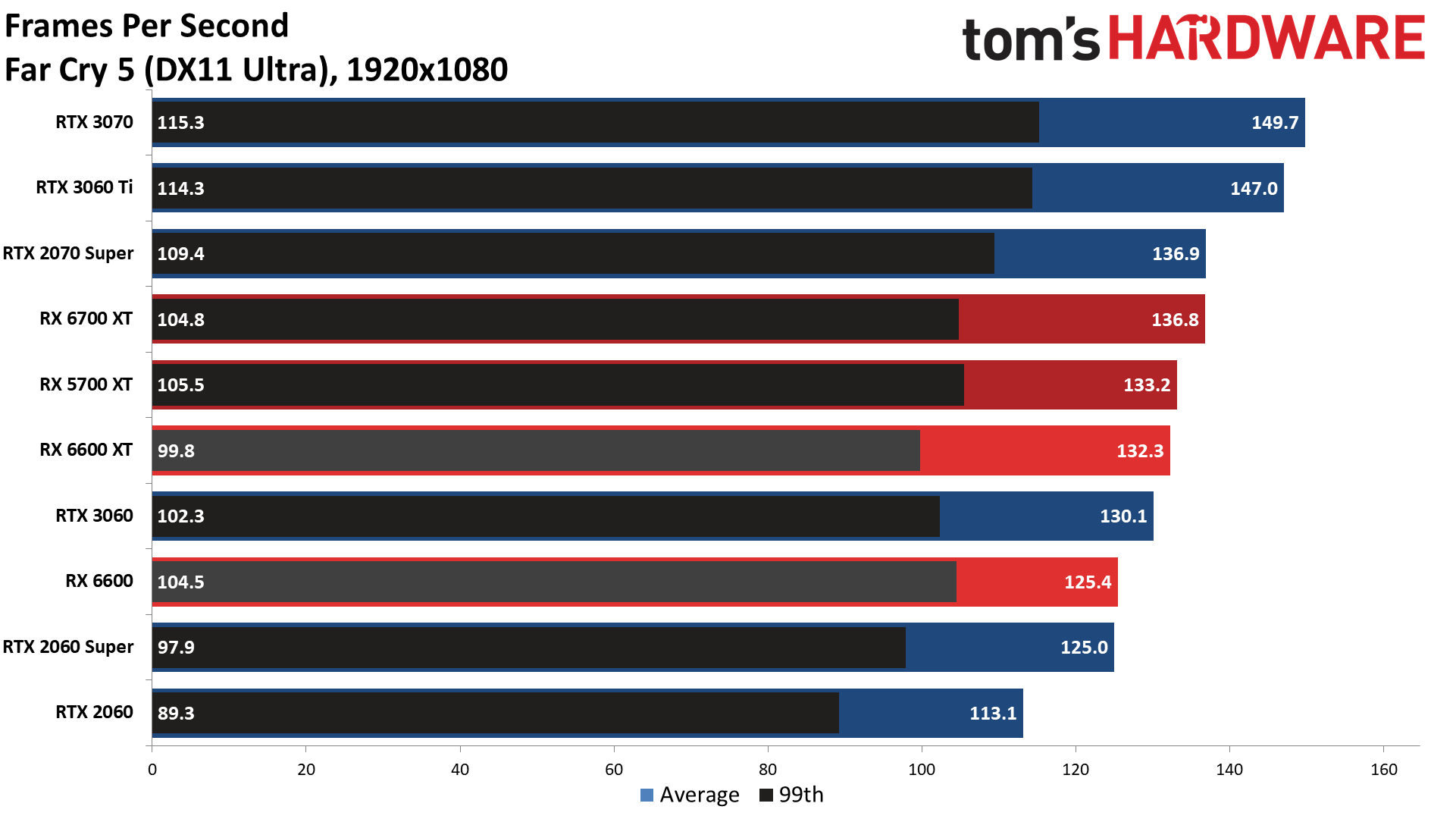
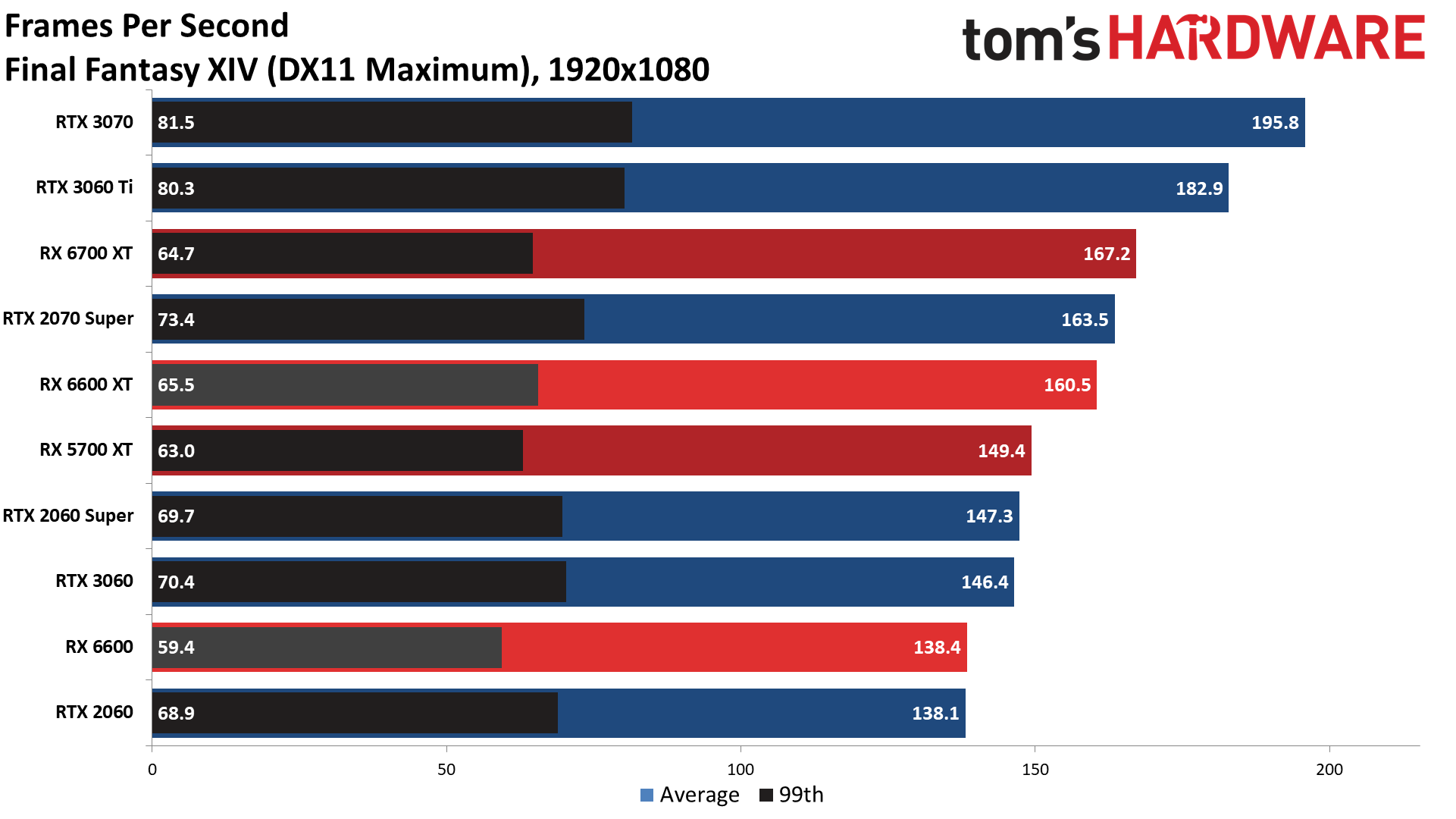

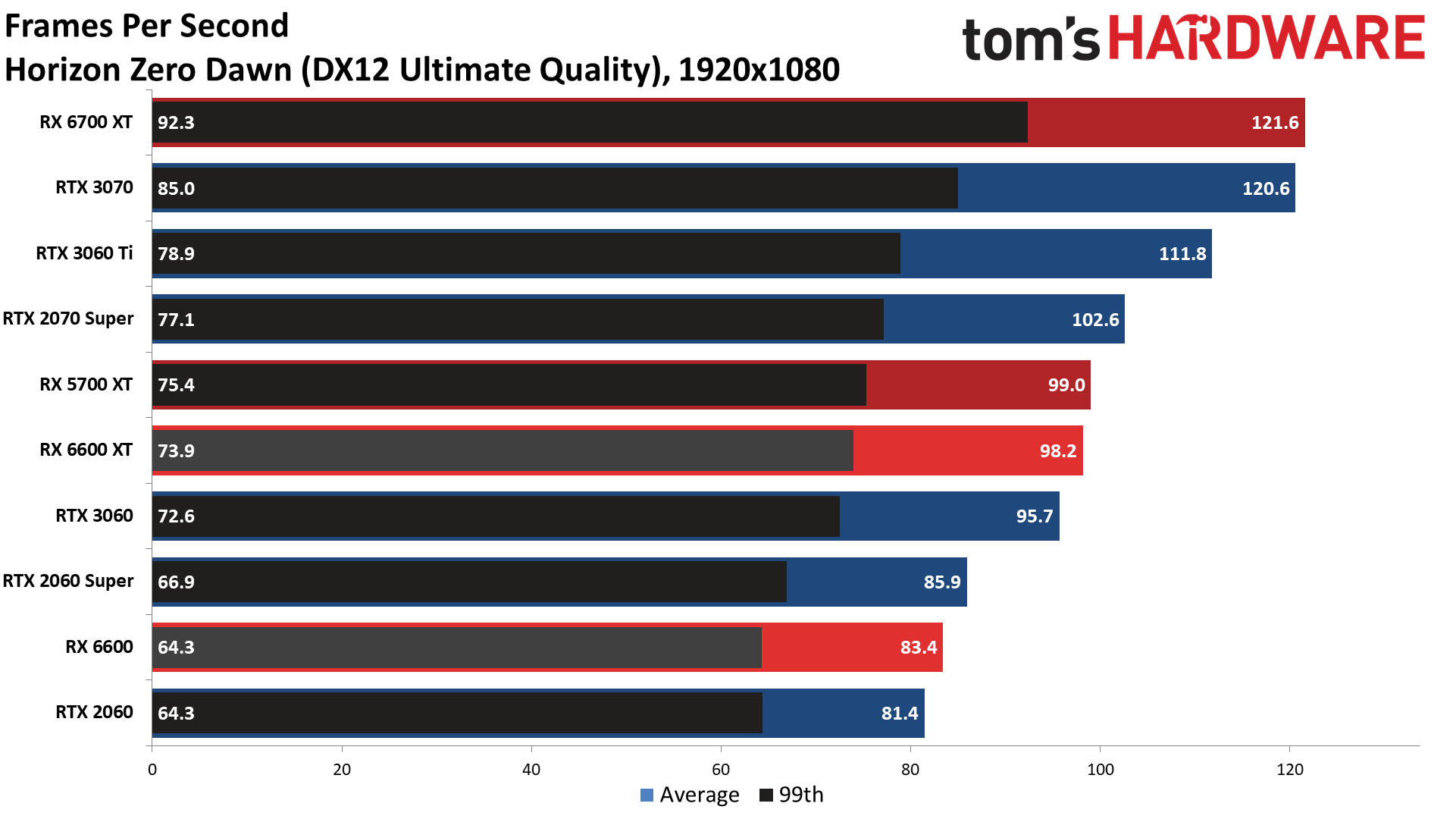
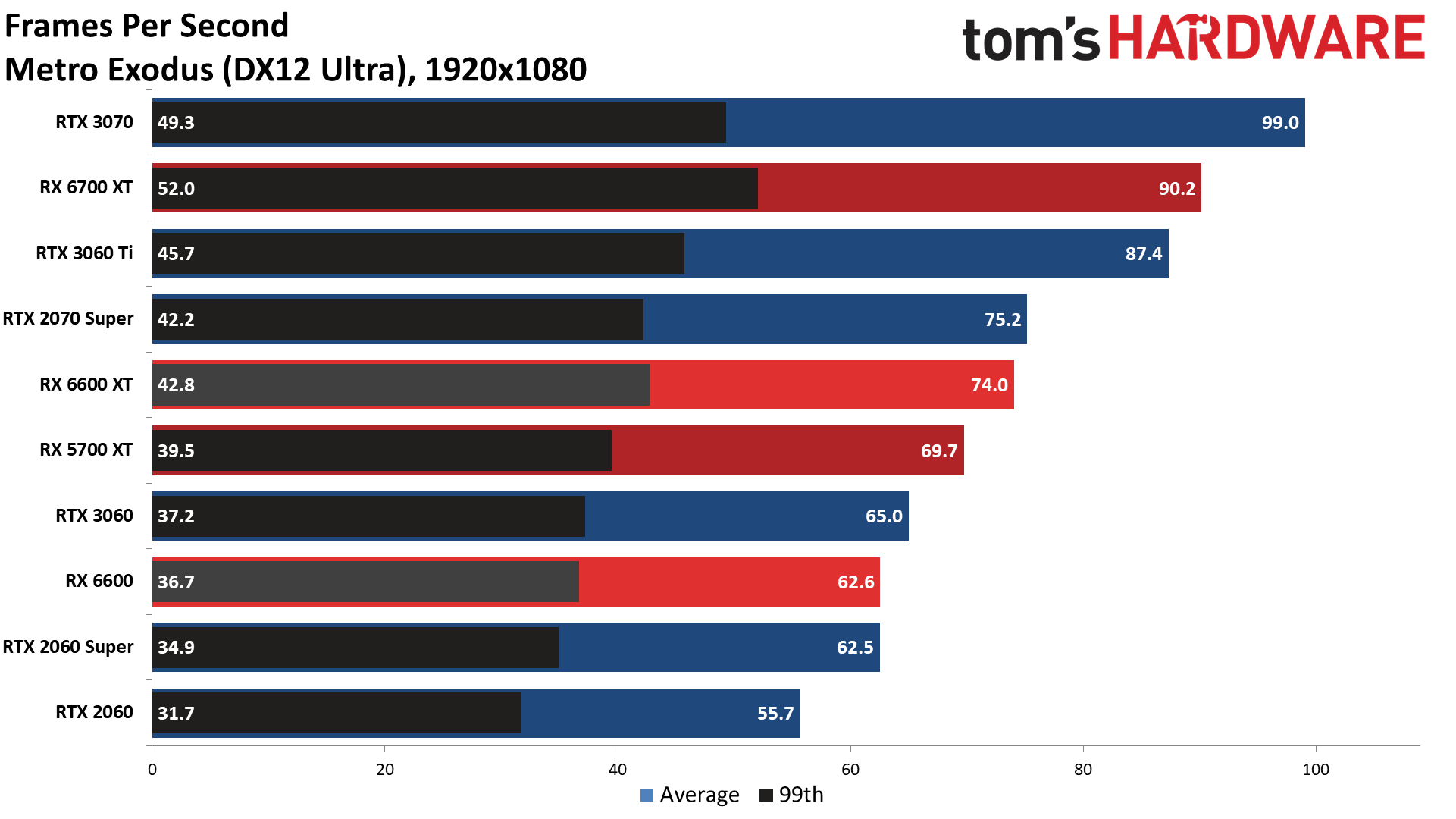


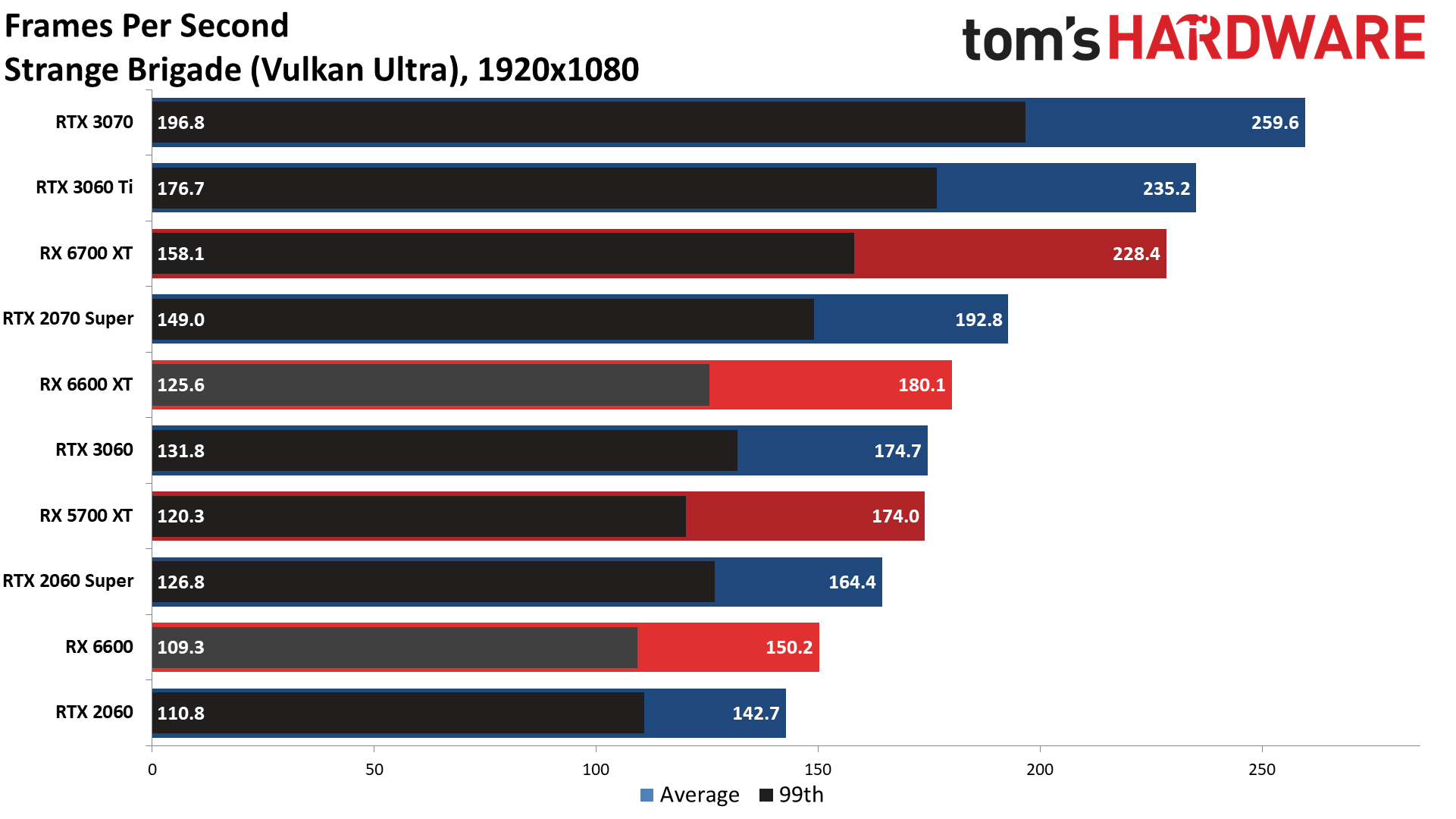
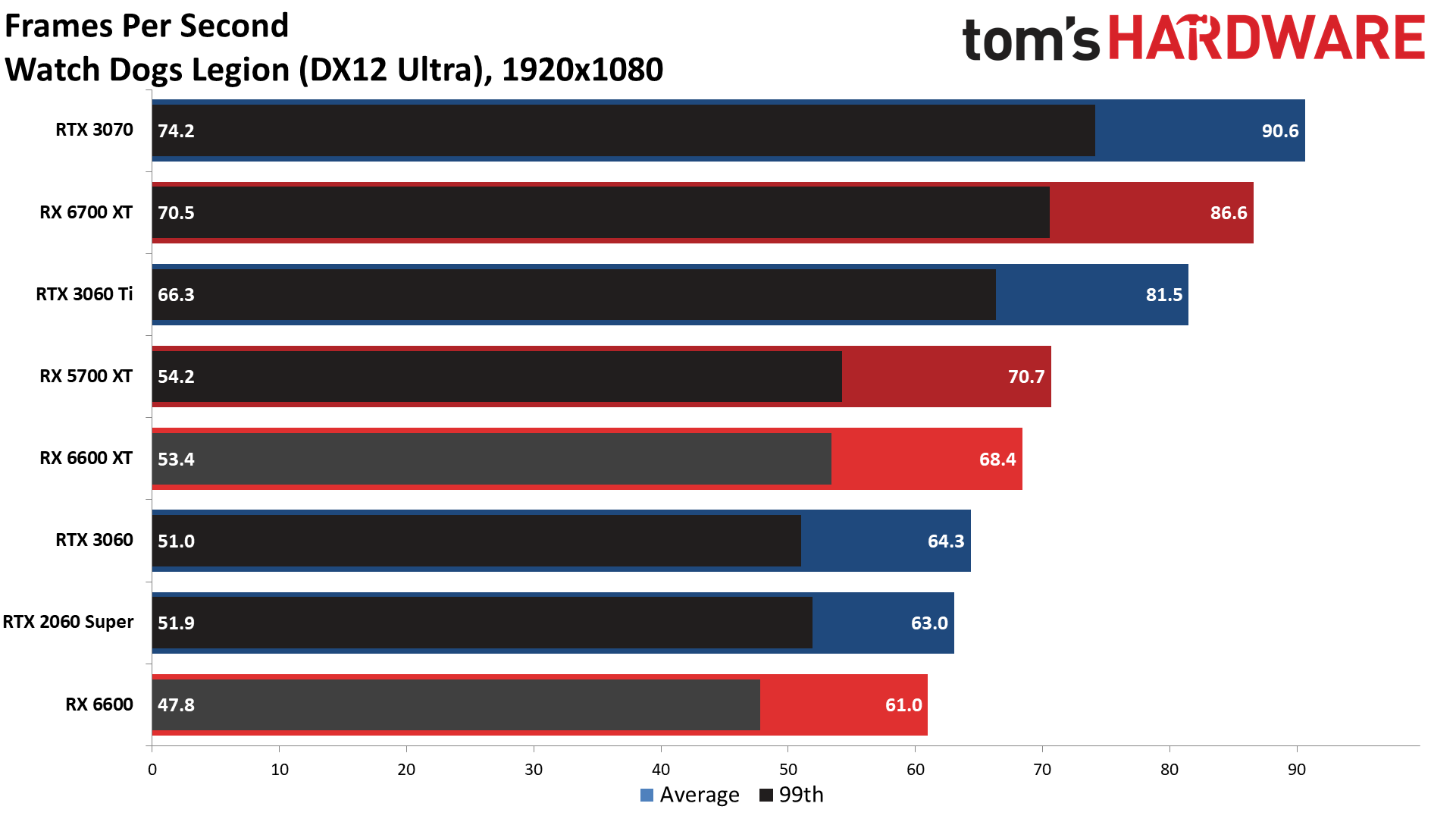
With 8GB of VRAM, 1080p ultra shouldn't pose much of a problem, and it doesn't. The RX 6600 averaged 95 fps across our 13 game test suite, and once again fell 13% behind the RX 6600 XT. It was also 2% slower than the RTX 3060, again reinforcing the fact that most games don't need more than 8GB of VRAM at this resolution.
Generally speaking, 1080p ultra runs quite well on the RX 6600, delivering roughly the same level of performance as the RX 5700 at 1080p (it was 2% faster). That card came out over two years ago and originally cost $349, though it was regularly available for around $310 for the better part of a year after launch — right up until the pandemic inspired shortages kicked in. As with the XT variant, we're not getting better performance for less money, but you do get roughly the same level of performance with a more efficient architecture.
Let's also take a deeper dive and look at the individual games. The RX 6600 leads Nvidia's RTX 3060 in several AMD promoted games (Assassin's Creed Valhalla, Borderlands 3, and Dirt 5) along with Forza Horizon 4. Everything else favors the RTX 3060 by anywhere from 2% to as much as 14%. The RTX 3060 would easily win out if both cards were available for their MSRPs, but we'll have to wait and see what street pricing looks like on the RX 6600 over the next few weeks.
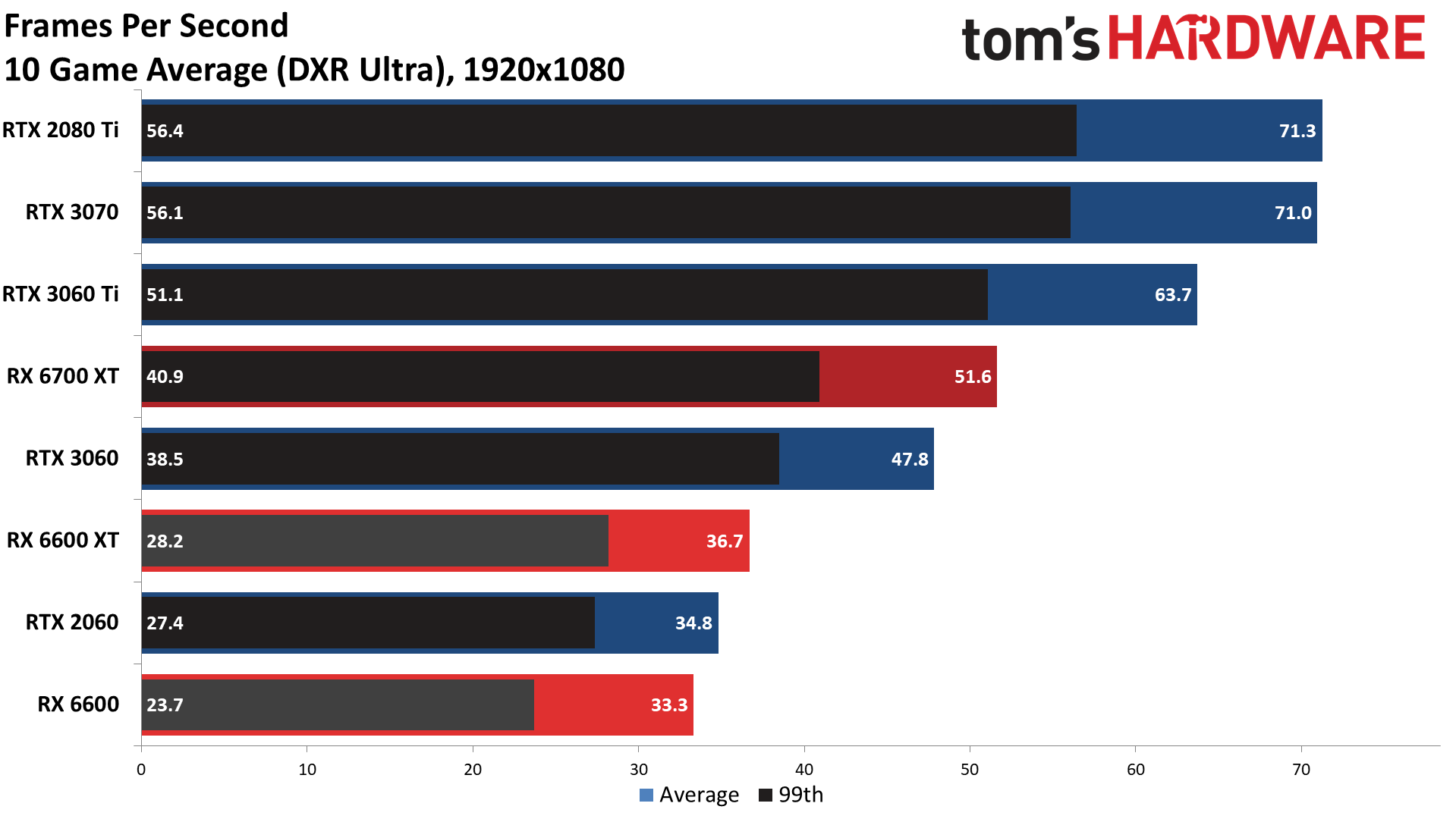
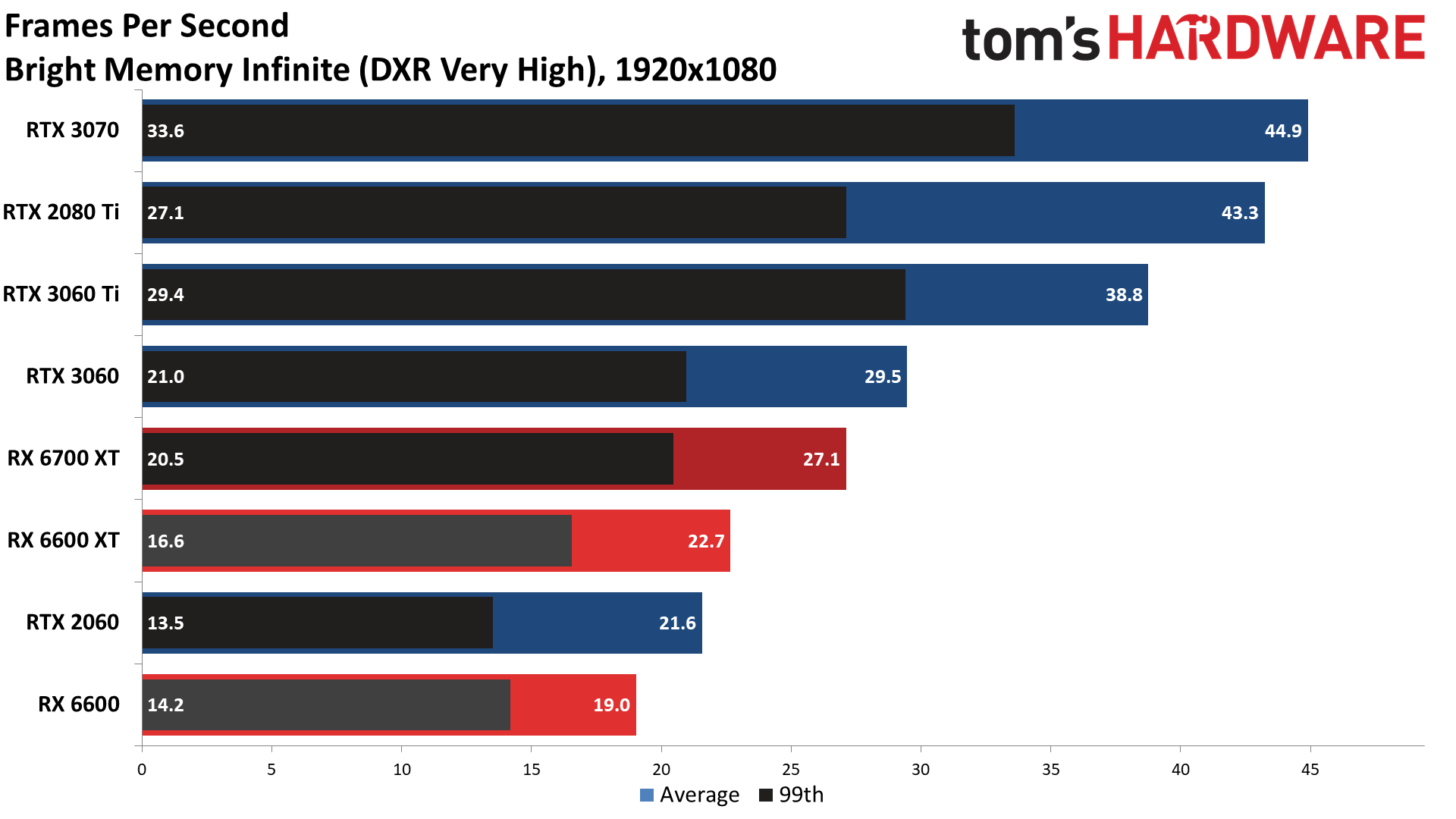
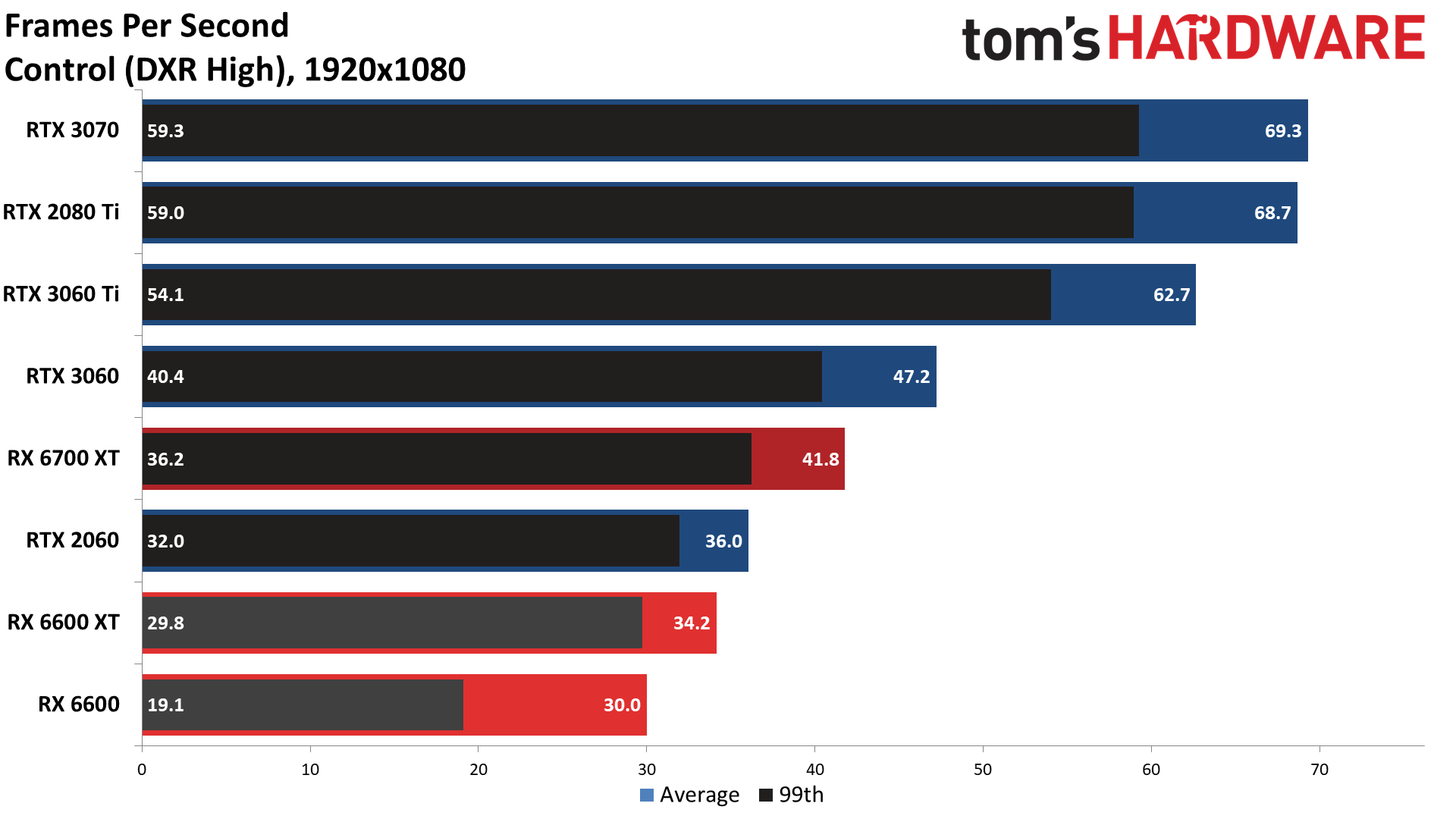
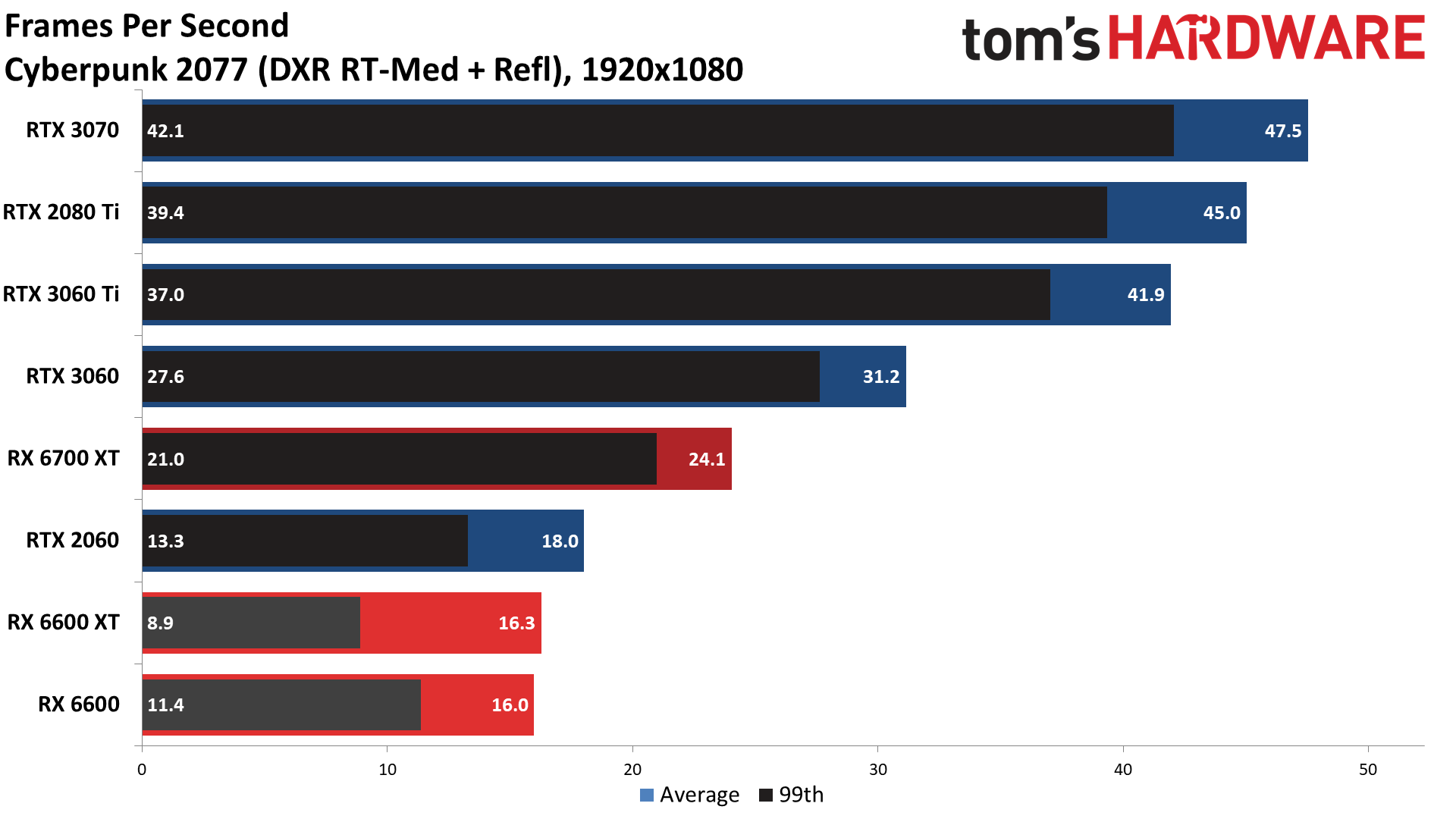
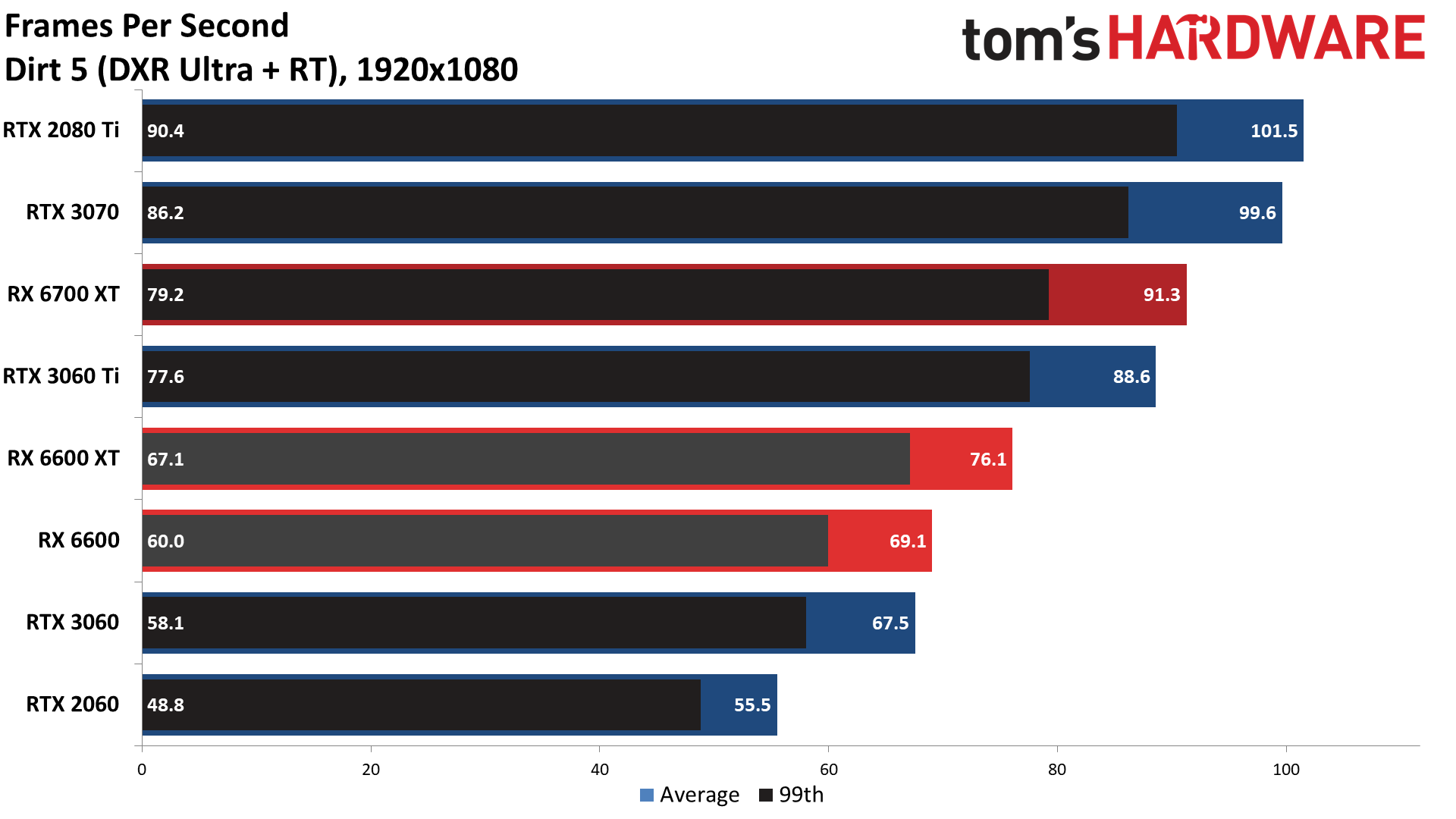


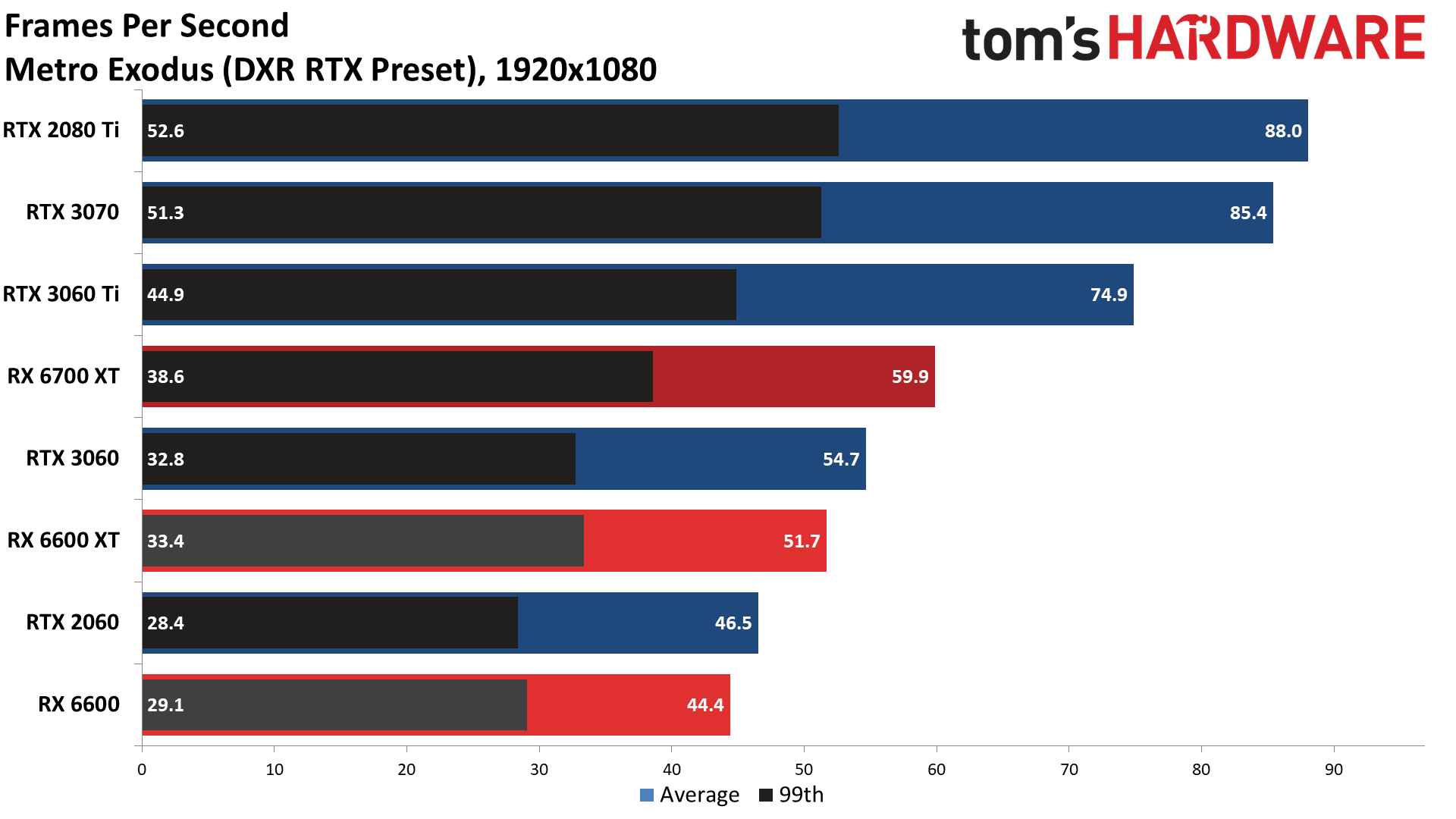
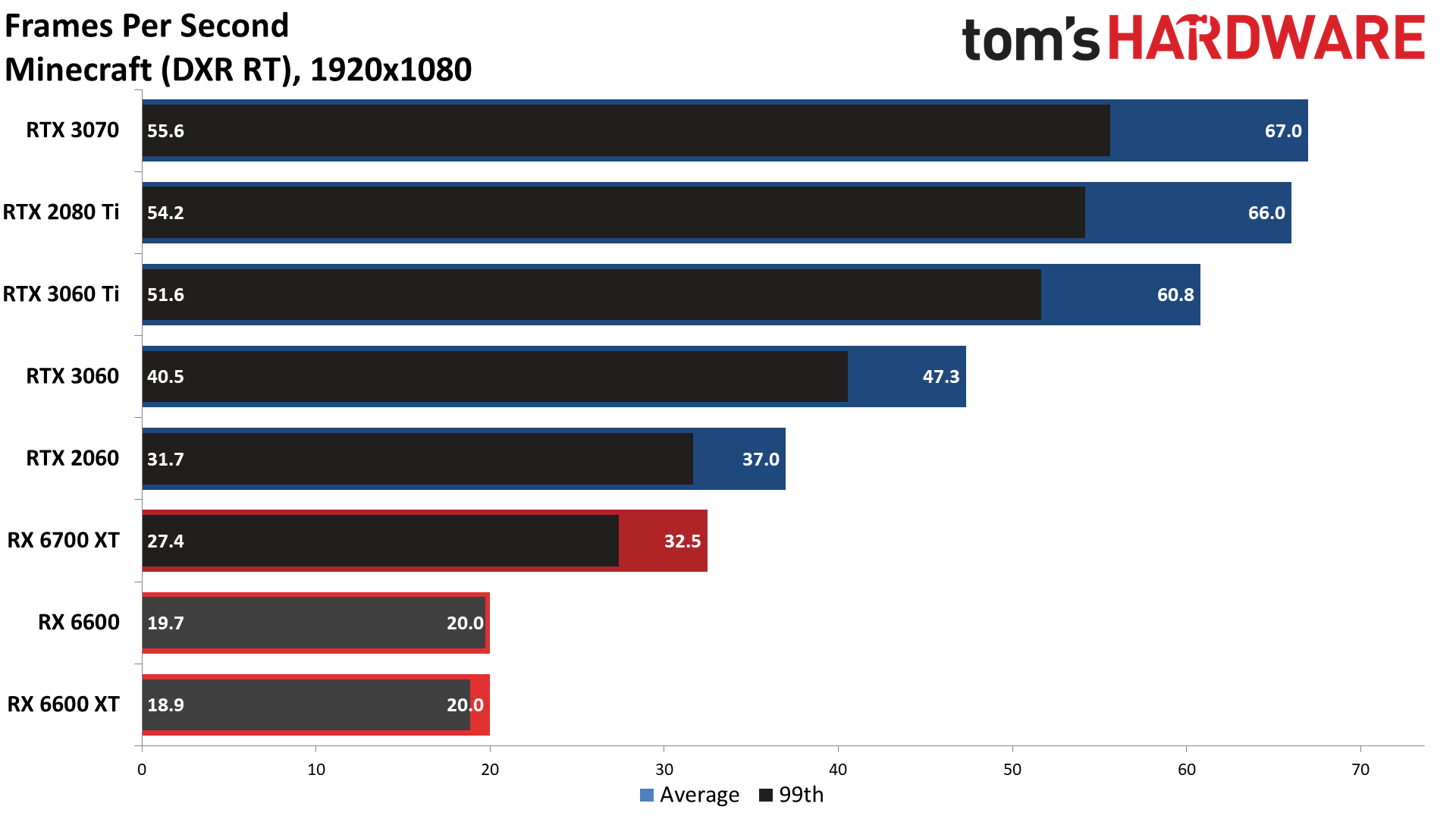
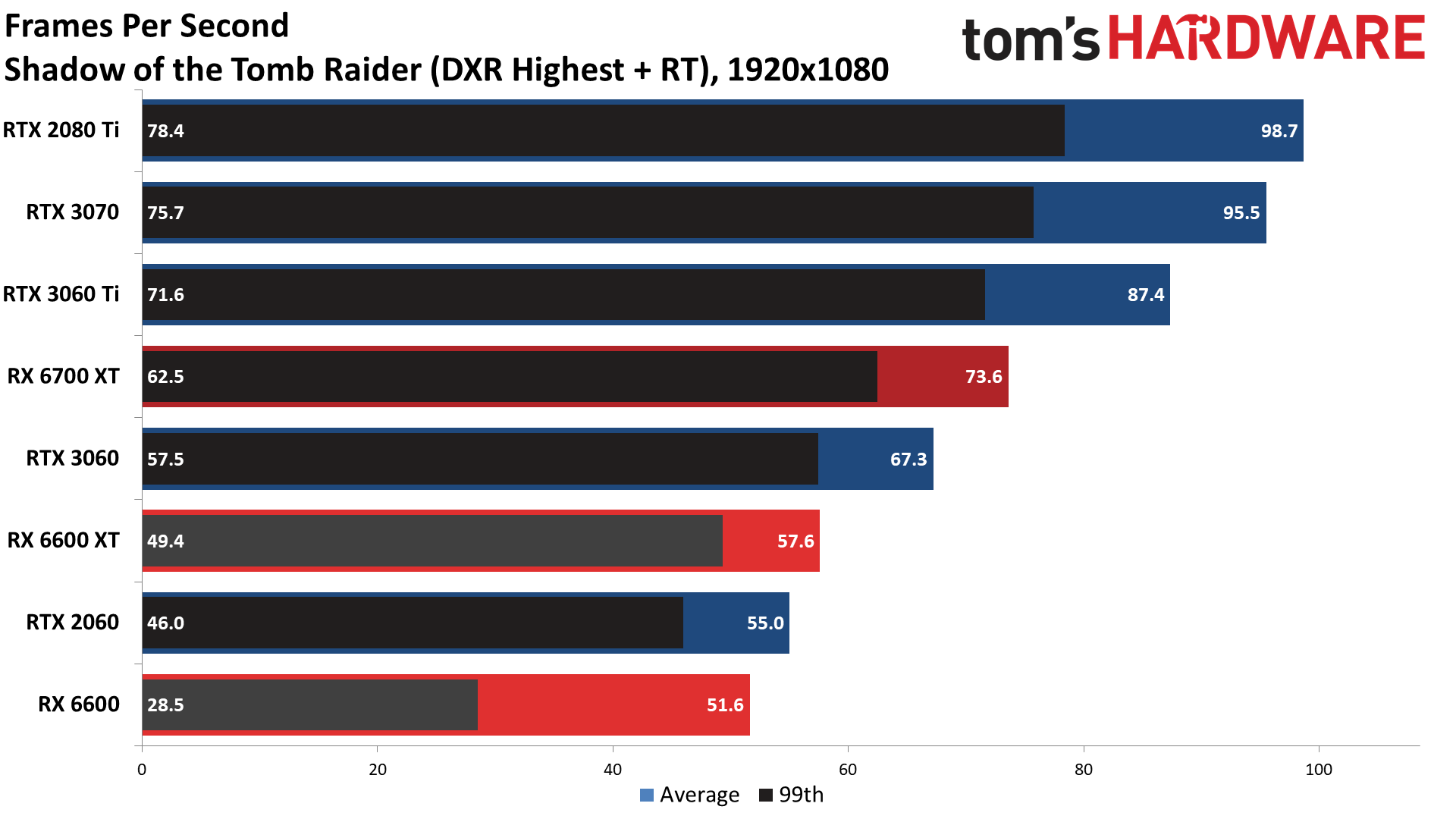
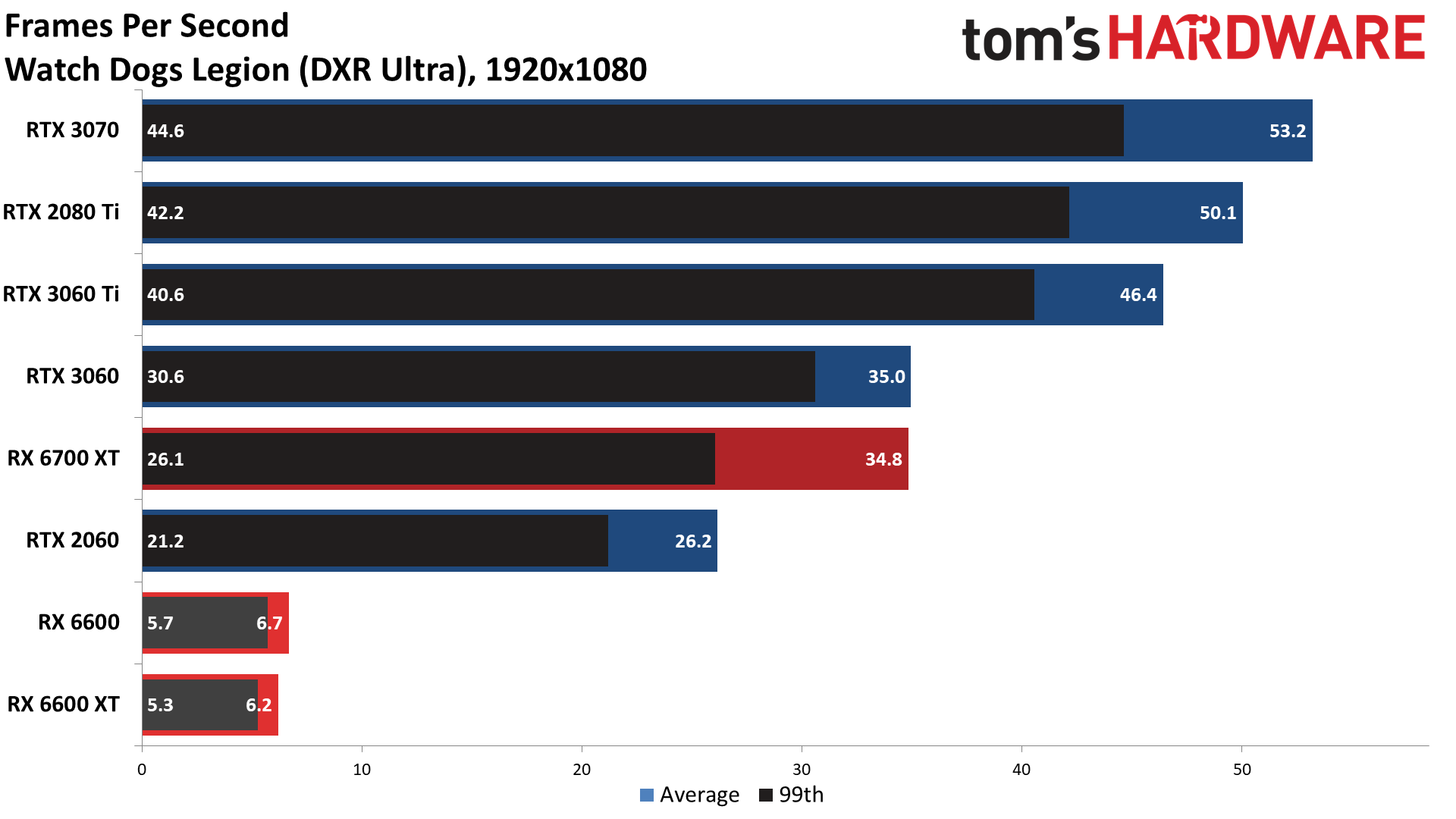
We're not going to do a separate page for DXR this time, because as you can see in the above charts, the less said the better. The more complex ray tracing games really don't do too well on the RX 6600. AMD's RDNA2 architecture doesn't have hardware accelerated BVH traversal, instead relying on shader code to do that part of the ray tracing algorithm, and that may be part of what causes performance to suffer — something for RDNA3 to fix. Whatever the case, games that use multiple ray tracing effects, and in particular games that aren't AMD promoted (looking at you, Godfall and Dirt 5) tend to perform quite poorly on the Navi 23 GPUs.
We didn't use DLSS or FSR upscaling here, so all of these results were run at native 1080p. Even then, multiple games were extremely unplayable at these settings. Of course, you wouldn't use maxed out settings with ray tracing if the result is sub-20 framerates, but we use the same settings across all GPUs. Also note that the games where performance really tanks (e.g., Cyberpunk 2077, Fortnite, Minecraft, and Watch Dogs Legion) can get a bit weird on minimum fps — the RX 6600 actually outperformed the RX 6600 XT from a couple months back, likely due to driver differences, but we're not going to get excited about either card when both are running at single digit framerates.
Not to put too fine a point on it, but AMD's RDNA2 GPUs simply don't work very well at ray tracing when they only have a 128-bit memory bus and a 32MB Infinity Cache. That appears to be the major sticking point, and it's a bit interesting as we've seen quite a few games where even the RTX 2060 with 6GB VRAM still does okay. For whatever reason, AMD's RX 6000 GPUs often need more VRAM than Nvidia's GPUs in order to get serviceable ray tracing performance.
Get Tom's Hardware's best news and in-depth reviews, straight to your inbox.
Current page: Radeon RX 6600 1080p Gaming Performance
Prev Page XFX RX 6600 Speedster SWFT 210 and Test Setup Next Page Radeon RX 6600 1440p Gaming Performance
Jarred Walton is a senior editor at Tom's Hardware focusing on everything GPU. He has been working as a tech journalist since 2004, writing for AnandTech, Maximum PC, and PC Gamer. From the first S3 Virge '3D decelerators' to today's GPUs, Jarred keeps up with all the latest graphics trends and is the one to ask about game performance.
-
Zarax Hi Jarred, would you suggest this card as an upgrade from a RX590 in an older PC (i7-3770k)?Reply
Thanks! -
kal326 Says these launch the 21st. Newegg shuffle hit early today and lists 8 rx6600 cards from ASRock, XFX, Gigabyte, MSI, Powercolor and Sapphire. They seems lower priced at the $329 level and I noticed they were non XT with first listing day of today.Reply -
King_V Reply
Not that I want to speak for Jarred, but the RX 6600, being somewhere in the same performance range as the RX 5600 XT or the RX 5700, would be a very noticeable jump from the RX 590, while also consuming a lot less power.Zarax said:Hi Jarred, would you suggest this card as an upgrade from a RX590 in an older PC (i7-3770k)?
Thanks!
That said, on that old i7, I think the only real problem would be possibly the motherboard. Sometimes, older motherboards are very finicky and won't work with newer video cards, most particularly when they're part of OEM systems like Dell and HP. -
-Fran- Ah, another "meh" release of a GPU. Only saving grace is going to be the real street pricing vs MSRP. So sad... So sad...Reply
Anyway, thanks a lot for the review; much appreciated as always.
Wasn't the Z77 chipset PCIe2.0? It would make the 6600 siblings run in X8 of PCIe2, so I'd imagine they won't perform as in these charts? Maybe close, but I wonder how badly they'll be constrained.King_V said:Not that I want to speak for Jarred, but the RX 6600, being somewhere in the same performance range as the RX 5600 XT or the RX 5700, would be a very noticeable jump from the RX 590, while also consuming a lot less power.
That said, on that old i7, I think the only real problem would be possibly the motherboard. Sometimes, older motherboards are very finicky and won't work with newer video cards, most particularly when they're part of OEM systems like Dell and HP.
EDIT: yep, 2.0 indeed: https://ark.intel.com/content/www/us/en/ark/products/64024/intel-z77-express-chipset.htmlEDIT2: Z77 with the 3770 does run in PCIe3.0; just want to clear that up just in case. It was pointed out later in the thread.
Regards. -
Zarax ReplyKing_V said:Not that I want to speak for Jarred, but the RX 6600, being somewhere in the same performance range as the RX 5600 XT or the RX 5700, would be a very noticeable jump from the RX 590, while also consuming a lot less power.
That said, on that old i7, I think the only real problem would be possibly the motherboard. Sometimes, older motherboards are very finicky and won't work with newer video cards, most particularly when they're part of OEM systems like Dell and HP.
Luckily it's not a branded PC but a custom build.
In my case I would use the RX590 to replace my wife's HD7970 and get the RX6600 for myself IF I can get it at MSRP. If not, I will keep playing lottery at AMD's website in the hope of getting something realistically priced. -
PiranhaTech When AMD misses the mark, they often have price adjustments and/or sales eventually... but they probably don't need to in this climate.Reply -
King_V @Yuka 's post does bring up a good point, though. That the 6600 is constrained to x8 PCIe, and that early era board you have is running PCIe 2.0, could make the 6600 a little slower than expected.Reply
I still imagine it'll do far better than the RX 590, though. -
Makaveli ReplyZarax said:Hi Jarred, would you suggest this card as an upgrade from a RX590 in an older PC (i7-3770k)?
Thanks!
As someone who is on a RX580 I think it would be better to go with the 6600XT model, but as other have suggested if you don't have a PCIe 4.0 motherboard makes this a more difficult decision. -
King_V Yeah . . I think even on PCIe 3.0, you'd still be okay. PCIe 2.0, on the other hand, is kind of an unknown in terms of how much of a choke-point that will be.Reply -
InvalidError Reply
Doesn't matter what the chipset is: the x16 slot is fed directly by the CPU and Ivy Bridge (3000-series) does support PCIe 3.0. Most 60-series boards with a hard-wired x16 slot (no x8x8/x8x4x4 bifurcation since 2.0 switches can't do 3.0) also got a free upgrade to 3.0x16 with an Ivy Bridge CPU installed.Yuka said:Wasn't the Z77 chipset PCIe2.0?
Kind of the reverse of how a lot of 300/400-series AM4 motherboard could do PCIe 4.0 when using a Zen 2 CPU until AMD pushed an AGESA update to block it.
As for the review/RX6600 itself, basically feels like overpriced tech from years ago. MSRP is about $100 more than it would have any right to in a remotely sane economy.